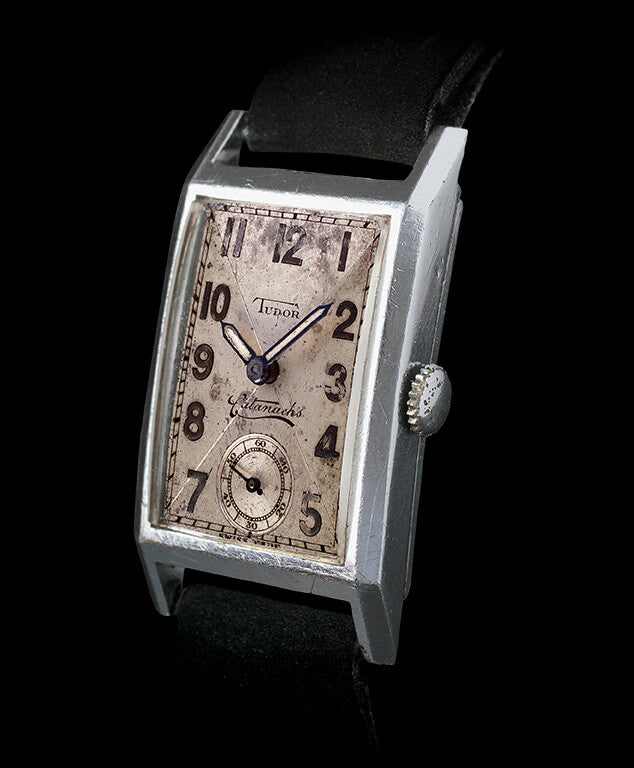A thorough explanation of the history and appeal of Tudor watches
Click here to watch a video about the history of Tudor.
In this article, I will explain how the Tudor brand was born, what representative models were created, and how it is still at the forefront today.I believe that by the time you finish reading this article, your perception of Tudor will have changed significantly, so please read to the end.
The table of contents looks like this.
1. A poor man's Rolex? The thoughts of Hans who created Tudor
2. History of Tudor : Its Beginnings
3. History of the Tudor Sign
4. 1952: Tudor Oyster Prince is born
5. 1954 Diving Watch: Submariner
6. The French Navy and Tudor Submariners
7. Tudor Fabric Straps
8. The Birth of the Oysterdate Chronograph Monte Carlo
9. Tudor Movement
10. Tudor's Heritage Collection and Recent History
Finally, here is a summary.
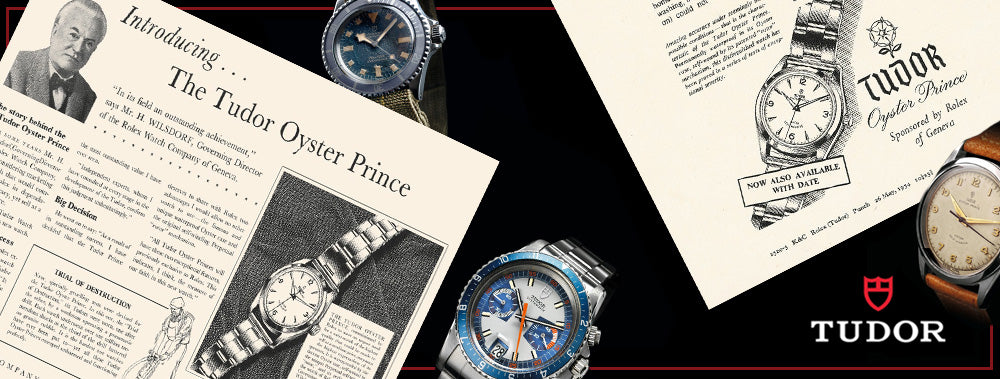
A poor man's Rolex? The thoughts of Hans, the man who created Tudor
In Japan, it is called several names, such as Tudor or Tudor, but here we will refer to the older ones as "Tudor" and the more recent ones as Tudor.
Some people see it as a "poor man's Rolex" (a watch for people who cannot afford a Rolex) , while others see it as a "watch brand with excellent cost performance."
Because of their high quality and reliability, their long, rich and interesting heritage, and the fact that you can wear watches from brands with the same history at a fraction of the price.
Today, Tudor is beloved by collectors and connoisseurs and we can state without hesitation that Tudor is a watch brand strong enough to stand on its own two feet.
Tudor was actually founded by Hans Wilsdorf, the same man who founded Rolex.
By the way, here is what Wilsdorf had to say about Tudor :
"I began thinking several years ago about whether it was possible to create a watch that distributors could sell at a more modest price than Rolex watches, but which would meet the reliability standards that Rolex is famous for. I decided to start a separate company to manufacture and sell this new watch. That was Tudor."
History of Tudor : The Beginnings
Tudor was founded in February 1926 by watchmaker Philipp Hueter at the request of Hans Wilsdorf.
The company name at the time was "Veuve de Philippe Hueter", and it began with the company signing an exclusive license agreement with Rolex.
At this time, it was not yet an acquisition, but rather an exclusive contract that allowed only Veuve de Philippe Hueter & Co. to handle Tudor watches.
The reason why he wanted to create a brand other than Rolex in the first place was that although Rolex had become very famous for swimming across the English Channel, it was a luxury item that not everyone could buy.
Wanting to solve this problem, Hans created Tudor, a cheaper version of Rolex.
The Rolex name also appears on rare Tudor pieces from this period.
This was because Rolex was already well established in the market and Tudor could use the Rolex name to gain credibility and influence.
" The Tudor brand's aim was to offer more affordable watches while still maintaining Rolex's reputation for quality."
To use the usual car analogy, Toyota cars came first, and Lexus was born based on that reliability, but Rolex and Tudor are in the opposite order.
The first Tudor watches were made in both men's and women's models and, like most watches of the era, were small dress watches with Art Deco designs.
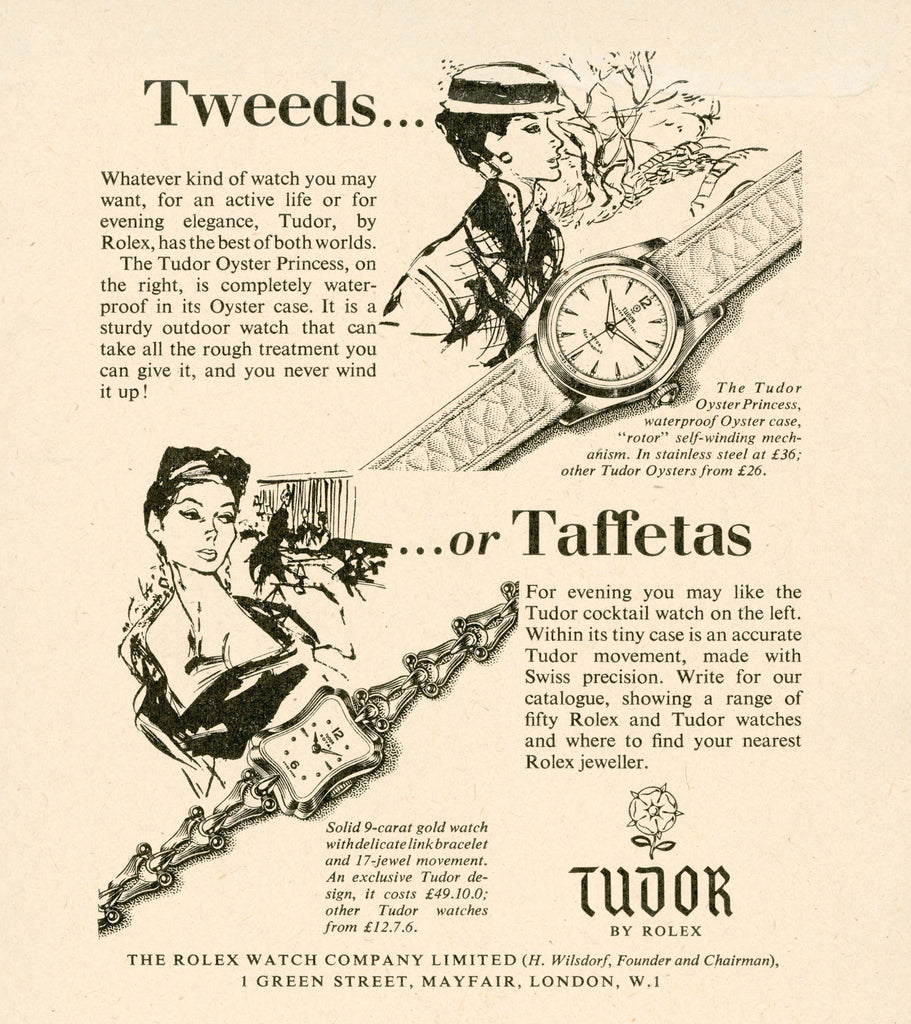
In 1932, Tudor introduced its first wristwatch in Australia, which was sold primarily to high-end jewellery stores.
Then, four years later in 1936, I'm not sure what happened, but Hans, the founder of Rolex, acquired Tudor, and thus Tudor became a subsidiary of Rolex.
History of the Tudor Sign
Signs from 1926 to 1936
The first Tudor watches had a simple TUDOR signature on the dial, with the horizontal bar of the T being longer than the other letters.
This was the first Tudor logo and today the sign is so rare that it is almost impossible to see it again.
Signs from 1936 to 1947
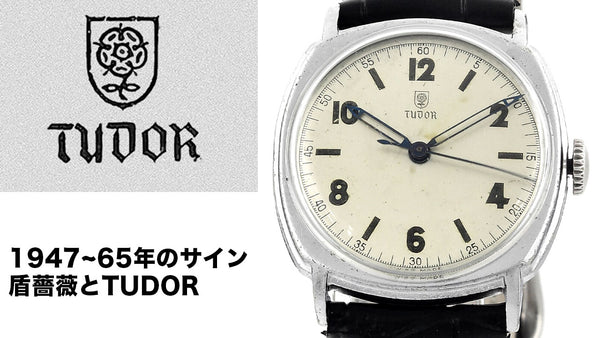
On October 15, 1936 , Hans Wilsdorf acquired Tudor from Veuve de Philippe Hüter.
During the same period, the iconic Tudor rose logo, now recognised by collectors and enthusiasts, began to appear on the dial.
The origin of this sign is the rose and shield mark, which are also the symbols of the House of Tudor, the royal dynasty of the Kingdom of England and the Kingdom of Ireland. It was designed to symbolize the invincible combination of the strength of a watch's reliability and robustness and the elegance of its beautiful lines.
The reason why the Tudor family chose this coat of arms was that England was the most powerful nation in the world at the time, and the rose was chosen because it would be loved by the English people.
Signs from 1947 to 1965
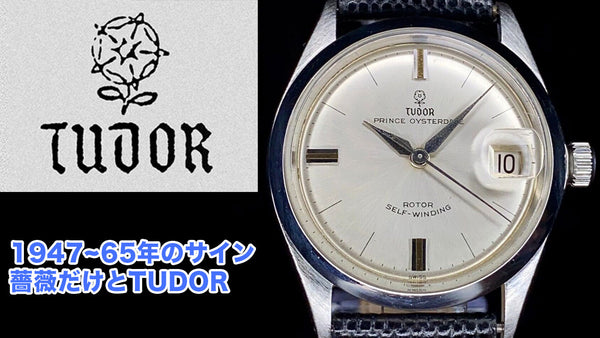
In 1947, the Tudor logo changed.
A year after Tudor's official launch, the shield gradually disappeared from the logo.
The new logo now consists of just Tudor's iconic rose with the Tudor name underneath.
Depending on the watch, the logo may be small and understated or so large that it covers the 12 o'clock number, emphasizing the brand's elegance and style.
Signatures from 1969 to the present


Although it was never explicitly stated that this was the case, I believe that the end of the Tudor dynasty meant that the rose could no longer be associated with the palace, and so the shield was left alone.
This shield includes, as mentioned earlier, durability and reliability.
1952: The Tudor Oyster Prince is born
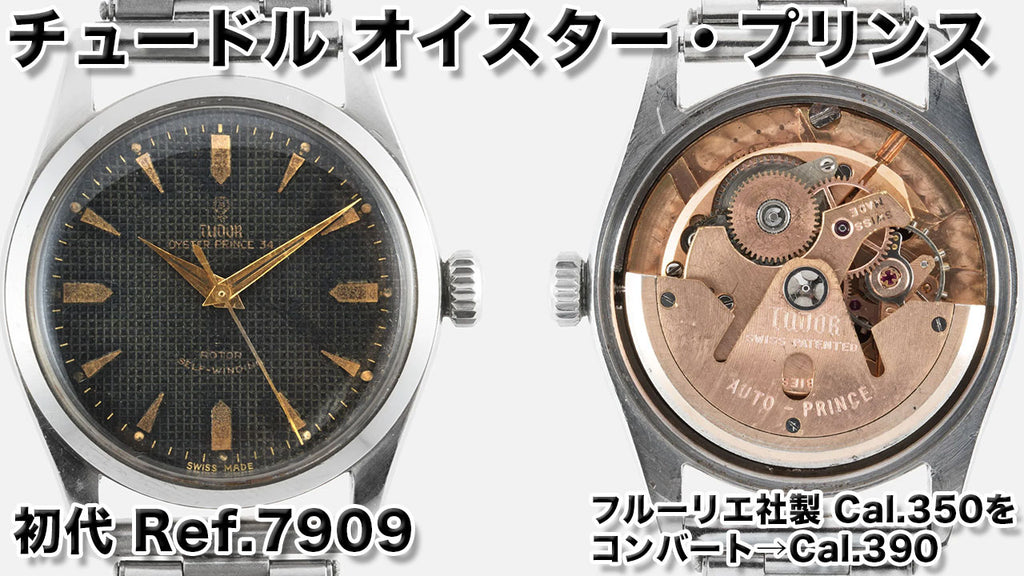

In 1952, the Tudor Oyster Prince was introduced.
During this period, the watch market was beginning to expand beyond just elegant dress watches to include more functionality.
The first step for Tudor was the Oyster Prince.
This was the Oyster case that Rolex had at the time, and it was never sold to any other companies.
However, this case was also adapted for use in Tudor watches.
That just shows how much Hans wanted to make Tudor a success.
The Tudor Oyster originally came in a 34mm case, reflecting the ideal size for a watch at the time.
So, when it comes to vintage watches, there are 31mm watches, but these are called boys' sizes and even this size was still a men's watch.
Hans also appeared in public for the first time in a special advert for Oyster Prince.
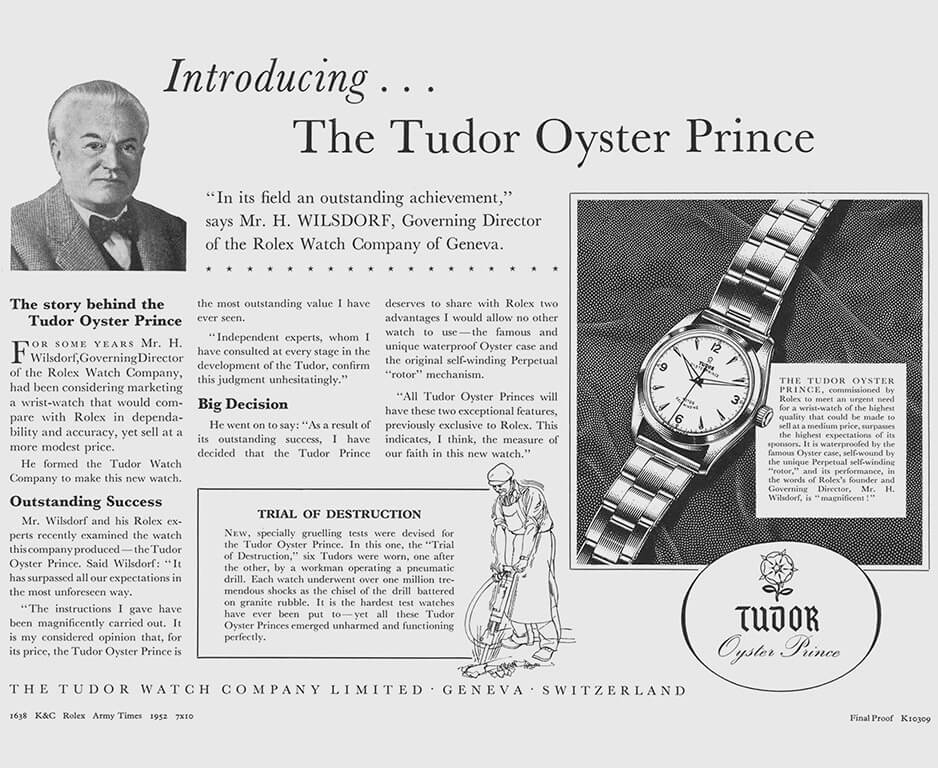
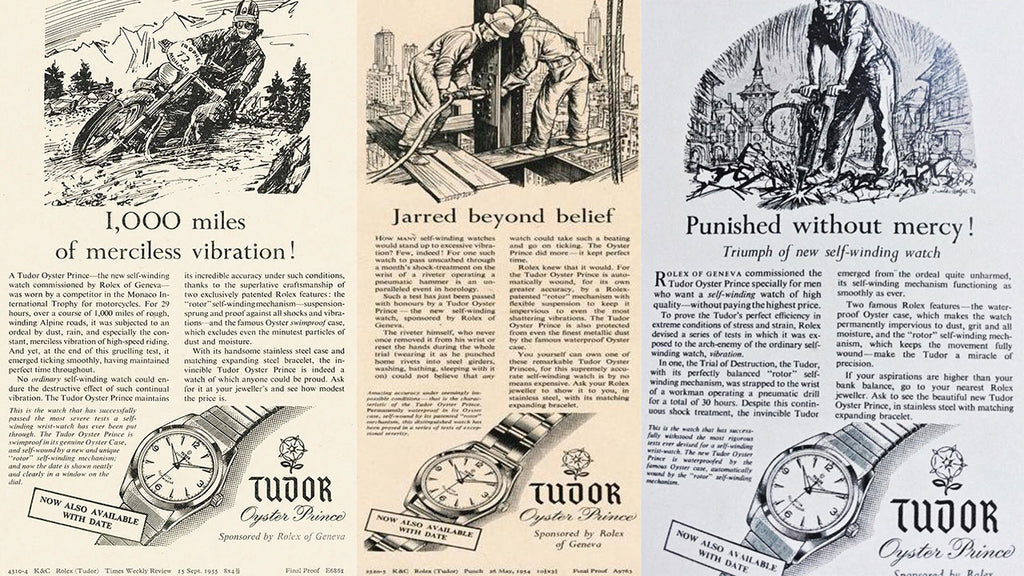
In 1952, the brand launched its own advertising campaign, emphasizing strength, reliability and precision, which was a departure from the image of elegant and delicate dress watches that was prevalent at the time.
The purpose of this was to show that it was an independent brand and not just a "cheap alternative to Rolex," and at the same time to appeal to the demands of the times of "durability" and "robustness" even in harsh environments.
The highlights of this campaign include:
1. "A watch worn by a coal miner who dug for 252 hours.
2. A watch that withstood the vibrations of a pneumatic drill for 30 hours
3. A watch worn by a stonemason for three months
4. A watch worn for a month while riveting beams during building construction
5. The watch used by a motorcycle racer to travel 1,000 miles
The point of all this was to present a watch that could be trusted even under the most extreme and demanding conditions.
The poster on the far left shows the watch being worn by a motorcycle racer who completed a 1,000-mile (1,600 km) race, and the two to the right show the watch working properly even when used with vibrating tools on a construction site.
Accompanying the Greenland Expedition
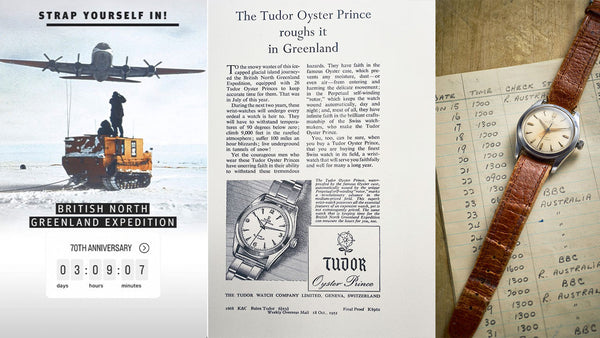
In 1952, 26 Tudor Oyster Prince watches accompanied the British Scientific Expedition to Greenland , organised by the Royal Navy and sponsored by Queen Elizabeth and Winston Churchill.
This was because Tudor watches were recognised as sporty and sturdy, and thanks to their Oyster case, which was directly borrowed from Rolex, their robustness was recognised; it was a real advertising success.
1954 Diving Watch: Submariner
Following the huge success of the Oyster Prince, Tudor then went on to produce a diver's watch.
Now let's take a look at the Tudor Submariner.
 Tudor launched its first diver's watch, the Oyster Prince Submariner, in 1954, and the first model was water resistant to 100 meters.
Tudor launched its first diver's watch, the Oyster Prince Submariner, in 1954, and the first model was water resistant to 100 meters.
Then, four years later, in 1958, the water resistance was further improved to 200m, which became a huge topic of conversation.
In this image, the first and second watches are waterproof to 100m, while the third watch is waterproof to 200m.
In terms of design, it is almost identical to the Rolex Submariner of that time, except for the logo.
Then, in 1959, the final model of the Ref. 7900 series, the Ref. 7928, was born.
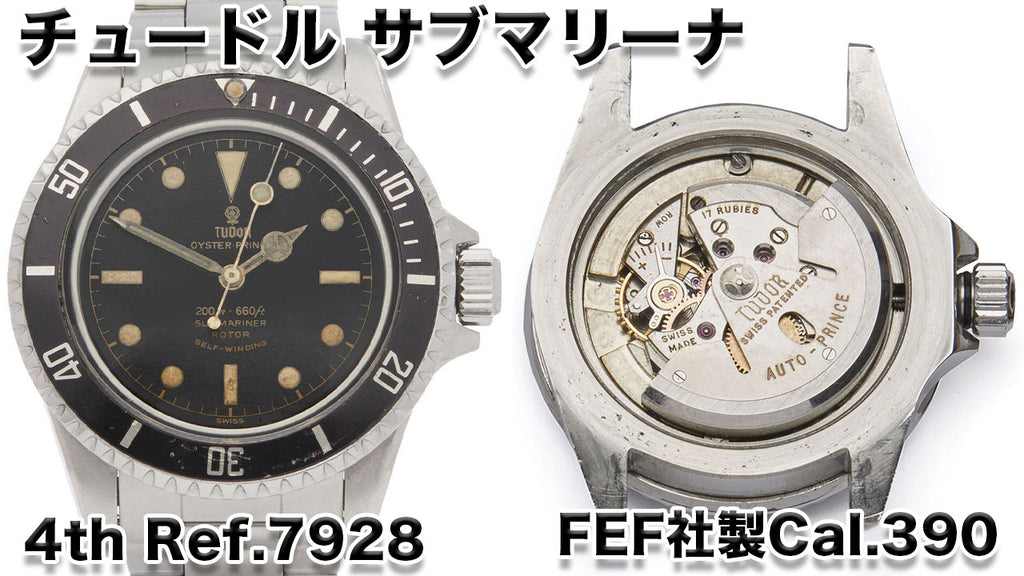
Even with a diver's watch, the impression changes greatly depending on whether or not it has a crown guard.
The Tudor Submariner evolved while following in Rolex's footsteps, and because it was equipped with a similar crown guard, production continued for about 10 years until the second generation was born in 1969.
This is the first generation, but it was from the second generation that the unique character of the Tudor Submariner began to emerge.
Second Generation Submariner

Previous models seemed to simply copy the Rolex Submariner design, but the second generation saw a major model change, resulting in the creation of an original Tudor design.
Broadly speaking, there are three changes.
The first is a design called "Snowflake," which incorporates squares into the indexes and hands.
This snowflake is so named because it looks like a snowflake.
In Japan, the name Ikasubu may be more familiar because the hook looks like a squid.
It's a big change from the dot design that was the default for diver's watches up until then, but it's innovative and cool.
The second is the movement.
As mentioned above, until then, the movement was made by Fleurier, but from the second generation it was changed to a movement made by ETA.
By switching to ETA production, it became possible to display the date.
The one shown in the image is the non-date version of Cal. 2483, while the version with date notation is Cal. 2484.
The third is the signature.
Until then, it was a shield rose, but it changed into the shield-only sign that we see so frequently today.
Due to these three major changes, the Tudor Submariner underwent a major model change from the second generation, and it transformed into its own brand, far removed from Rolex.
The French Navy and Tudor Submariners
The French Navy recognized Tudor's quality and durability and signed a contract to purchase their watches.
Tudor became an on-site research and development partner, providing detailed feedback on what worked well and what needed to be improved.
Commercially available Submariners were also a big hit, but the difference between them and the French Navy model is whether or not they have MN (Marine Nationale) engraved on the back cover.

But why did the French Navy choose Tudor out of all the other watch brands?
This is because Tudor watches offered the reliability and quality of a Rolex Submariner, but at a more affordable price point.
This was the vision that Hans Wilsdorf entrusted to Tudor, and the submariner delivered to the French Navy is the result of Tudor's successful fulfillment of that vision.
Now let's take a look at the history of the fabric straps that Tudor gave away free of charge.
Tudor Fabric Strap
As mentioned above, the French Navy began using Tudor watches, and by the late 1960s they were purchasing large numbers of watches without bracelets.
This means that all belts were either military-issued or of the wearer's own choosing.
This continued into the mid-80s.
This was not simply a cost-cutting move by the French Navy, but also for safety reasons.
In 1973, the British Ministry of Defence debuted the NATO strap, a two-piece strap that provided an extra level of security if one of the pins broke.
NATO straps were also used by many professional divers because leather straps are waterproof and can be worn over a diving suit more easily than a metal bracelet.

For these reasons of functionality and safety, we prepared and used our own NATO straps.
In the early 2000s, watches with NATO straps became a trend among the general public, and many people began wearing watches with these straps.
Tudor picked up on this trend, and in 2010, the Heritage Chrono was released with a fabric strap in addition to the metal bracelet.
Since then, all Tudor Heritage models have come with a complimentary fabric strap, but around the time of the announcement of the new Black Bay with an in-house movement, Tudor discontinued the complimentary fabric strap.
(We will explain in-house movements in the next chapter.)
So, if you buy a Tudor watch today, you won't get a free strap.
Instead, the Heritage model can be purchased with your choice of a bracelet, leather strap, or fabric strap.
You also have the option to purchase the strap separately.
I have handled a Tudor fabric strap once, and I can tell that it is thick and much more carefully made than the ones sold in stores.
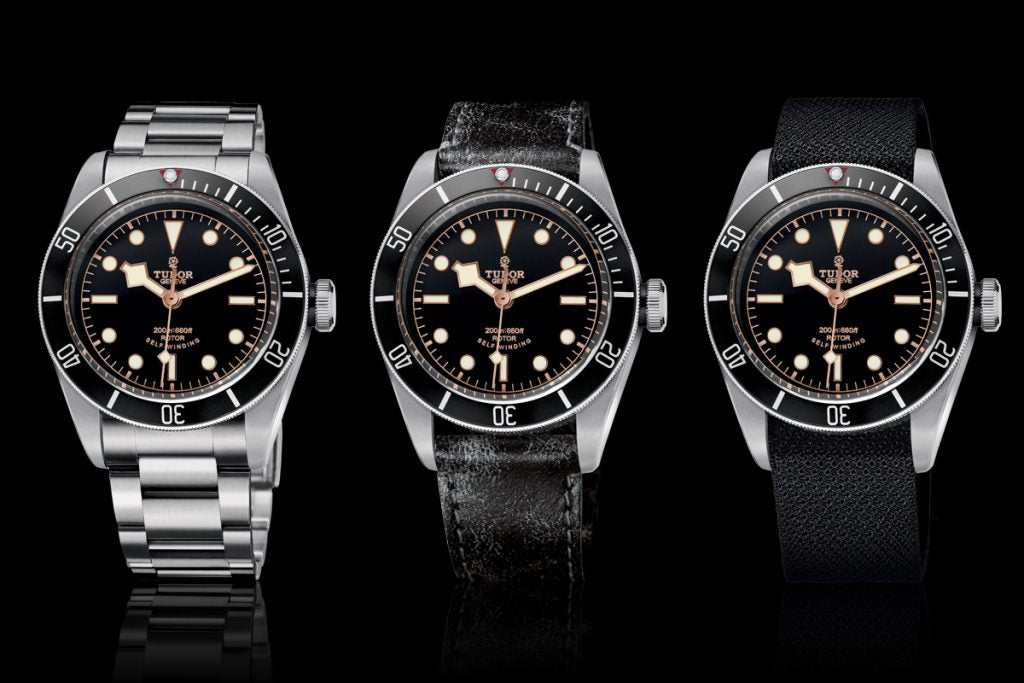
Incidentally, the fabric strap is woven by a passementerie manufacturer near Saint-Étienne, the silk weaving centre of France since the 15th century.
1957: Tudor launches its first alarm watch
1957 was an important year for Tudor, as it was the year they introduced their first alarm watch, called the "Tudor Advisor".
This is the only model ever to feature an alarm function.
Additionally, three different "Tudor Advisor" models were produced between 1957 and 1977.

Two of these featured Oyster-type cases, the references 7926 and 1537.
And finally, we have the reference 10050, which features a new dedicated case.
In 2011, Tudor resurrected this model under the reference 79620T.
Of course, it has been redesigned for the modern market, but it still creates a clear and close link to this important period in Tudor history.
The Birth of the Oysterdate Chronograph Monte Carlo
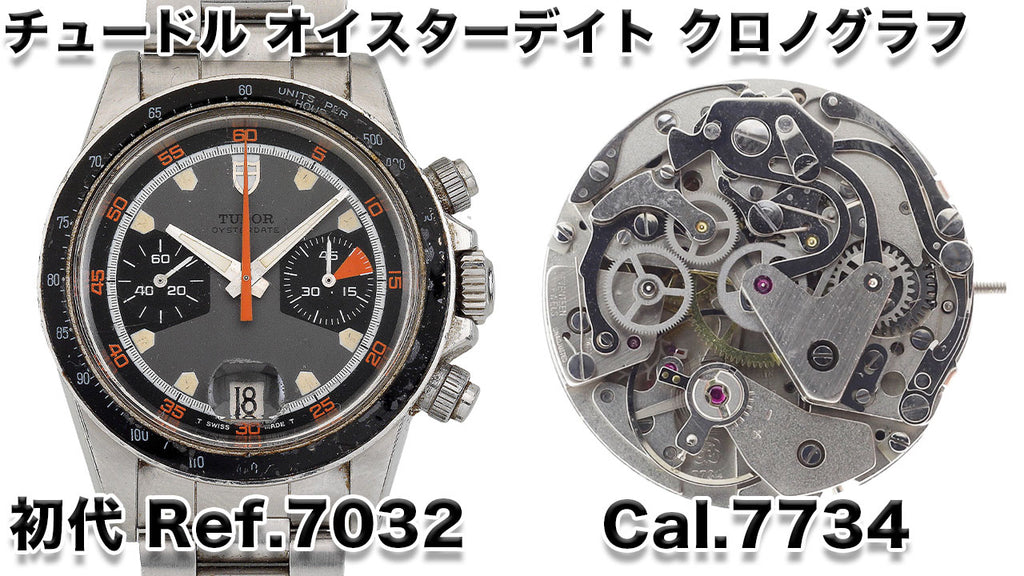
In this chapter, we will look at the relationship between Tudor and Rolex chronographs.
In 1970, Tudor introduced its first chronograph.
This Oysterdate is equipped with a hand-wound Valjoux mechanical caliber 7734 and features a chronograph function with a cam mechanism.
By the way, at that time, the Rolex Cosmograph Daytona was equipped with the Valjoux Cal. 722.
The Rolex Cosmograph Daytona was born in 1963, seven years earlier than Tudor.
However, chronographs, like the Submariner, did not immediately follow suit.
It was in the Rolex chronograph position.
Rolex chronographs are now extremely popular and trade at high prices, but back then, Omega's Speedmaster, Breitling's Chronomatic, Heuer's Autavia, and others had already established their positions, and Rolex had not yet established itself in the sports chronograph market.
In 1965, the Cosmograph underwent a major improvement.
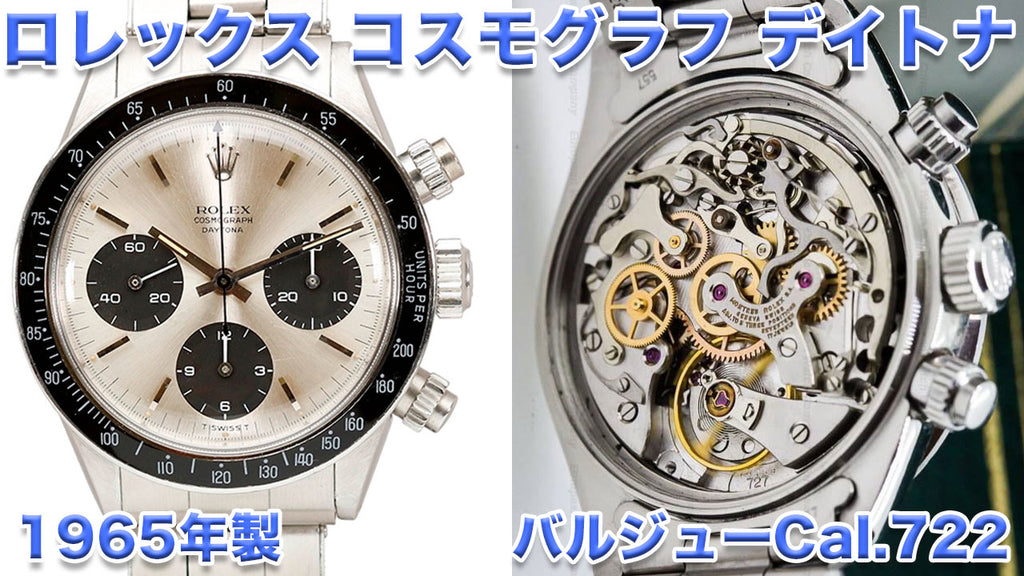
The chronograph pushers were also screwed down, resulting in a new model with high water resistance.
This has enabled Rolex to establish a new and unique position.
If we apply this to Tudor, five years after the release of the new Cosmograph Daytona in 1965, Tudor decided that the popularity of the model in the market was good enough that it would work, and so they created a model with the same screw-down pushers.
The Oyster Date Chronograph was introduced in 1970, but the first model was only produced for the first year, with the second generation being released as early as 1971.
This second generation is the more commonly known model, and is very popular and known as the Monte Carlo combination, because the scale of the dial is reminiscent of a casino roulette.

Now, let's take a look at the second generation while looking at this image.
First of all, at first glance you might be wondering, "What's the difference between this and the original?", so I'll explain the differences between this and the original.
The first is the design of the dial.
Although this is the first generation, the entire dial is designed with a trapezoid motif.
The sub-dials are trapezoidal and the indexes are shaped like a home base.
By the second model, they were much more subdued and had a more choppy, regular look to them, in the typical '70s chronograph style.
The second is the needle.
The first generation needle is thick at the base and gets thinner as it goes further up, but the second generation has a rod-shaped needle, which was also commonly seen in the 1970s.
Next, let's take a look at the second generation types.
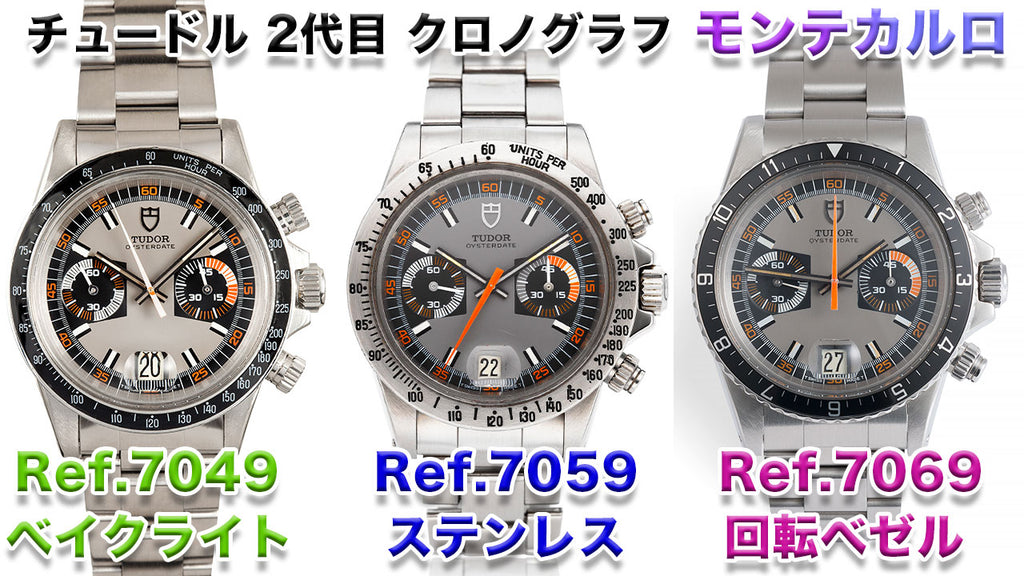
The second model is available in three patterns: Ref. 7049 has a bakelattice bezel, Ref. 7059 has a stainless steel bezel, and Ref. 7069 has a regular rotating bezel.
Incidentally, the first model was also released in the same type, but the rotating bezel type only ended up as a prototype and was never put into production.
The design is based on orange, gray, and black, and has the sportiness and innovativeness that is unique to the 1970s, so even we today think it looks very cool.
Tudor Movements
Originally, Tudor used Rolex quality cases and bracelets, but equipped them with ebauche movements, allowing them to offer Rolex-like reliability and durability at a lower price.
Therefore, if you look at old Tudor watches, you will see that the exterior uses the same parts, and the bracelets and crowns are also engraved with Rolex.
In recent years, Tudor has evolved significantly as a manufacture.
In 2015, the company successfully developed its own in-house movement.
In 2015, the same year the movement was completed, Tudor equipped its first in-house movements in the Pelagos and North Flag watches (production of which was discontinued last year).

This three-hand movement, Cal. MT5602, has a power reserve of approximately 70 hours and is equipped with a free-sprung balance that makes it easy to adjust accuracy.
It has also been certified as a chronometer, which is proof of its high precision, and boasts specifications that make it impossible to call it a cheaper version of Rolex.
Some of their watches now feature in-house movements, allowing Tudor to produce everything in-house without relying on Rolex.
Many people don't care about the movement, but it is an important element of a watch, and for Tudor to be classified as a genuine watch manufacturer rather than just a watch assembler, promoting the appeal of its in-house movements may be an important step for the future.
Tudor Heritage Collection
Although Tudor has a long history and a reputation for making high quality and reliable watches, the presence of the Rolex brand has actually hindered them (kind of like a second generation celebrity).

In 2010, Tudor released the Heritage Chrono, inspired by the 1970s Tudor Monte Carlo.
It was their first heritage-inspired watch, and its success encouraged Tudor to consider repurposing other models.
In 2011, the brand launched the alarm watch "Heritage Advisor" and "Fastrider Chronograph" collections.
2012 was a significant year with the release of the Heritage Black Bay, a reinterpretation of Tudor's early Submariner models.
The Heritage Black Bay was an instant hit with collectors and enthusiasts of vintage style, as it embodied all the charm of Tudor's vintage diving watches in one watch.

It also makes sense that, given Tudor's close association with diving watches, this would be a very popular type of watch.
In 2013, the Heritage Black Bay won the “Revival” award at the Grand Prix d'Horlogerie de Genève.
Tudor introduced the Ranger in 2014, inspired by the military watch of the same name that was released in 1967.
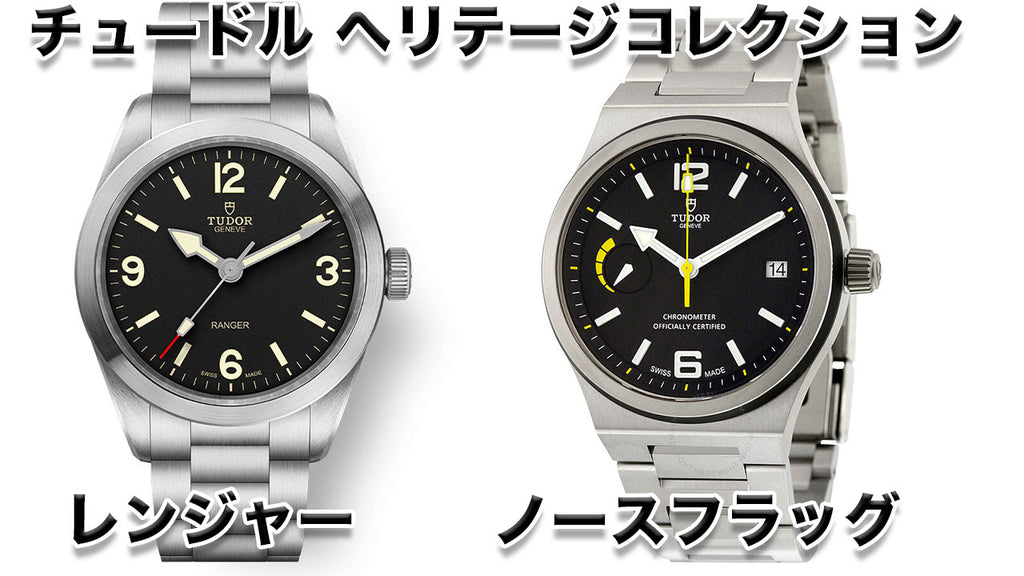
The Ranger is a field watch that incorporates a variety of vintage designs.
The North Flag, launched the following year in 2015, was named after a key moment in Tudor history: the 1952 British Expedition to North Greenland.
As mentioned above, the North Flag was Tudor's first model to feature an in-house movement.
The Tudor Pelagos, released in the same year, was waterproof to a depth of 500m, making it a true diver's watch.
Additionally, the Pelagos won the "Sports Watch" award in 2015.
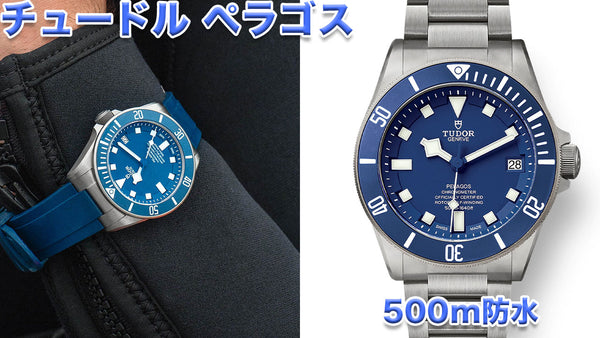
Between 2016 and 2017, Tudor introduced "manufacture" movements into all of their sports watches, including the Black Bay.
summary
We have explained only the most important aspects of Tudor watches.
Looking back at their history, it would be reckless to lump them all together as cheaper Rolex versions and show a failure to understand their true capabilities.
Until 2015, watches were equipped with movements from other companies, but still, watches from the rose logo era were traded at high prices.
Looking at things like this, even if it will never become a Rolex, it may rise to the status of a top brand like Omega or Breitling in the future.
What a great brand with so much potential!
I believe that this brand is Tudor, which became independent from Rolex and established its own manufacture.


